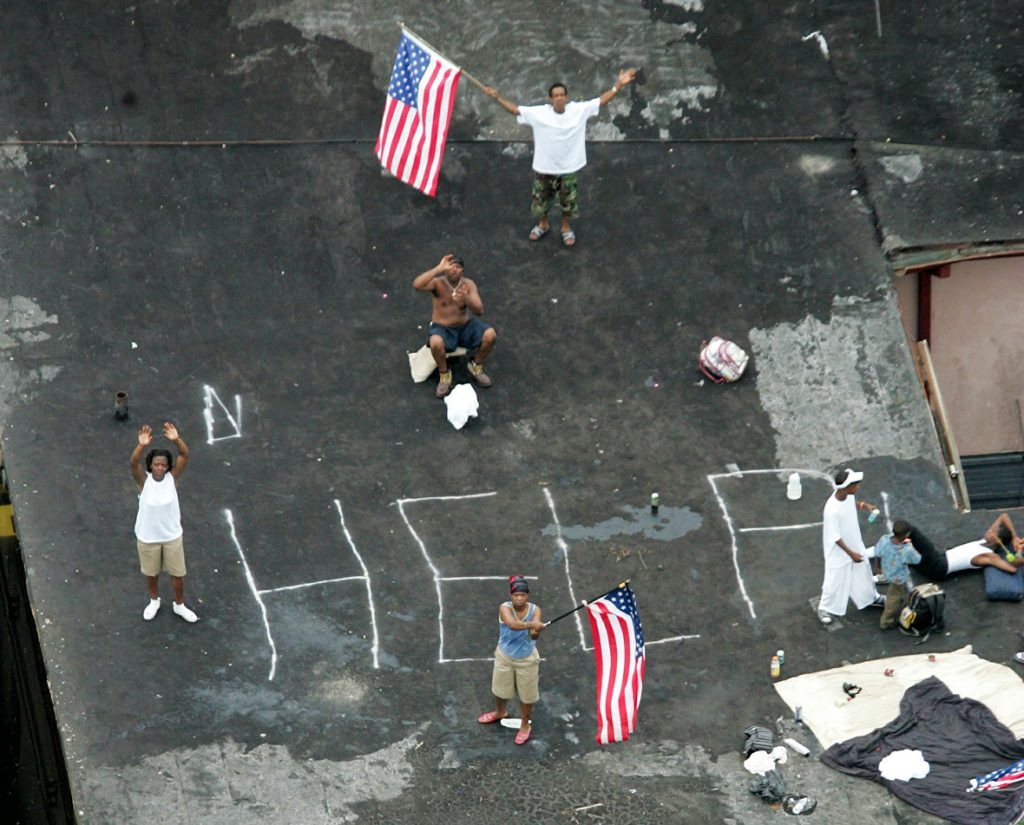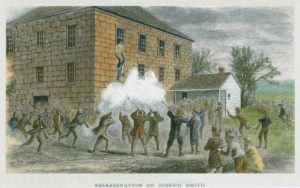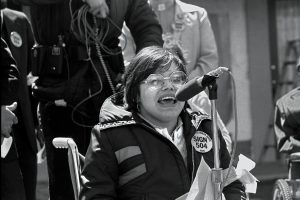
With its blends of French, Spanish, German, African, Irish, and Native American influence, Louisiana is very culturally diverse. Folk tales, spicy food, Jazz music, and its swampy perimeter come together to form a very deeply connected and proud population that is unlike any in the world. With its known reputation of care free fun and dramatics, the community was struck with a disaster that ripped apart its world. Not only did such disaster impact the community of Louisiana, but it affected the whole country and all who enjoyed its lifestyle.1
Hurricane Katrina was the largest recorded and third strongest hurricane to hit U.S. soil. The levees built in Louisiana were built for a category 3 hurricane. However, Katrina peaked at a category 5 with winds reaching 175 mph making it very difficult for people to fight back. The death toll was 1,836 people. This number does not include the 705 people who are still reported as missing.2
The population of Louisiana was severely impacted with nowhere to be sheltered from the wrath of the storm they call Hurricane Katrina. This not only impacted but also enlarged the homeless population dramatically. With homeless numbers not seen before, any and everyone was accepted. Hurricane Katrina moved through New Orleans in August of 2005. This is almost exactly twelve years before the Hurricane Harvey similarly devastated the Houston area in August of 2017. Harvey has now devastated the Texas Coastline and left thousands homeless and out of work. The relief that has been demonstrated this past month is much different from what was demonstrated in 2005. Hurricane Katrina hit a part of America where there was a high percentage of minorities, mostly African Americans, many living in low income family housing. This was a difference between Louisiana and Corpus Christi and Houston where the latest Hurricane hit, where there is a much larger variety of people that come from many different backgrounds. Unfortunately for the New Orleans area, this meant slower relief to be had by those affected. Those in power, like the President at the time, George Bush, were accused of not caring about “blacks.” He didn’t show up or officially offer help as fast as most believed that he should have. The long term effects were deadly to say the least. There were 1,836 people killed by the storm. The storm hurt so many people and it was their will to live that truly saved their lives. One family, the Browns, are living miracle workers.3

The three-person Brown family lived through the storm and even lived to tell their story. Andre and Alisha had just bought their first home. They had a baby boy, Andre Jr, who was also recently born. They were minorities, and in their words, “forgotten about.” Andre has described how they chose to stay at their own home, and how he had just replaced the roof himself, and was confident that it could hold. That is until the levees broke. The water rushed all the way up to their second floor, and his family rushed up the stairs and into the attic, and then onto the roof. There they waited, and about 24 hours later they were picked up by some neighbors who had a boat. They were taken up to a large overpass with about two-hundred other people who had lost everything. These people he described as getting desperate and mean. They were robbing people and taking their possessions. On the fourth day of being on the over pass with no food or water, they saw an 8 year old try to climb up onto the over pass. He slipped and fell fifty feet and no one did anything to help. Everyone was exhausted and over agitated due to robbers lurking everywhere. The only thing Andre Brown could think about was that he and everyone on that bridge had been forgotten about. It was calm and fine enough weather for rescuers to come and save them. But they didn’t. There were no helicopters flying over nor rescue teams on their way. He knew that everyone on that bridge were minorities, mostly black. He lived in a black area called Gentilly, and felt as though he would have been saved a lot sooner if he had lived in a white neighborhood. This is when he knew he had to leave and save himself instead. It was then when Andre Brown started to scan the entire bridge. He saw an old man lying on a air mattress and decided to ask him for help. He went up to him and pleaded with the man to loan him that air mattress. The old man looked him in the eye and then looked at his wife and baby, and without a word, gave the Brown’s his mattress. Once the family was on the mattress and in the water, his wife and baby start crying and wanted to go back. Andre Brown did not stop pushing away from the bridge though.Three hours later, the mattress hit something in the water. It was a dead body and Alisha Brown started to come undone. Andre Brown now had to calm down his wife and hold on to his little baby. His perseverance is what got them to his sister’s house, and they were overjoyed by their good fortune. His sister had been sustaining herself and family for two weeks and was so happy when her brother showed up at her house.4 Finally, a week after they arrived at his sister’s house, everyone in his sister’s house was evacuated. This is much different from what happened in the days after Harvey hit. No one was left behind like they were in Katrina.

Since all of this devastation, all the Brown family wanted to do was give back and help someone every day.5 Their family has fully physically recovered from the Hurricane. They have rented a new house in New Orleans and have gotten back into the workforce. Andre Brown is a delivery man in the home and style section of a local furniture store. He and his three-person family are back in the swing of life, going to work, raising a child, and living every day to the fullest.6 They still remember and think about Katrina often. They mention that it is normal for Katrina to be brought up within the first sixty seconds of conversation when meeting a new person in New Orleans. Most everyone has a story to tell. Even though it was devastating, it was also very humbling. It happened to everyone and now everyone has had to start over. Most believe they are better for it. It allowed the community to come together and grow from such devastation and become something new and fresh. Many who loved and supported New Orleans fled the streets of Louisiana to rebuild what was damaged. From state to state and even other countries, Louisiana was being carried into a new light of rebuilding. Millions of those touched by the tragedy offered a helping hand with donations of food, money, and supplies for those who were affected. The new reputation of Louisiana is something of resilience and a new-found humbled attitude. The state had it tough before, but is now even more grateful for being able to come back and make better after all of the destruction.

Hurricane Katrina was definitely a learning experience for all it affected and even for all who only heard about it. New Orleans is a place where millions go each year to party and leave their troubles behind. Now that New Orleans has experienced its own troubles, people around the world are able to look to it for wisdom. Though efforts for Louisiana may have come slower than needed, this state continues to strive to be home to many unique people. Learning to listen to mother nature and to help those around you is something many live by to this day. It was the acts of many who made this tragedy a new success story. A devastating hurricane is what they got, but what they came away with was a little more resilience, their Lagniappe as they would say. They might not have asked for deathly waters and winds, but in the end, they are a stronger people because of it.7

| Courtesy of David J. Phillip
- Nancy Roberts, “The Response to Hurricane Katrina: A Practitioner-Academic Exchange,” Public Administration Review 66, no (2006): 799. ↵
- National Oceanic and Atmospheric Administration, “Hurricane in History,” National Hurricane Center, Accessed November 1, 2017 https://www.dosomething.org/us/facts/11-facts-about-hurricane-katrina. ↵
- Patrick Sharkey, “Survival and Death in New Orleans: An Empirical Look at Human Impact of Katrina,” Journal of Black Studies, no (2007): 482-501. ↵
- Jim Gabour, “Hurricane Katrina Ten Years on,” The Guardian, August 2015, https://www.theguardian.com/us-news/2015/aug/27/katrina-survivors-tale-they-up-and-forgot-us. ↵
- Viki Mayer, The Production of Extras in a Precarious Creative Economy (Precarious Creativity: Global Media, Local Labor; University of California Press, 2016), 63-73. ↵
- Population Association of America, May 2010, s.v. “Employment and Self-Employment in the Wake of Hurricane Katrina,” by Julie Zissimopoulos and Lynn Karoly. ↵
- Ismail White, Tasha Philpot, Kristin Wylie, and Ernest McGowen, “Feeling the Pain of My People: Hurricane Katrina, Racial Inequality, and the Psyche of Black America,” Journal of Black Studies 37, no (2007); 523-38. ↵



38 comments
Alise Balderas
The featured image is heartbreaking, but was what drew me to the article. My family has taken trips to New Orleans throughout my childhood and it is such a pretty and interesting place, so it is amazing to see the city’s strength and beauty after this huge disaster. Reading this article is hard, especially after Hurricane Harvey hitting my home Houston, Texas. It is hard to understand something until it happens to you or affects you directly. My family and friends suffered from Hurricane Harvey and I can only imagine the devastation the people of New Orleans felt.
Alexis Renteria
Reading this story, makes me so thankful that me and my family have not gone through something as terrifying like hurricane Katrina. The amount of people that died and the rest that went missing just show how much a natural disaster like this can change people and make them fight for their and their family’s lives. The story of the Brown family also show how bad the situation was and the things people had to do to survive. Overall, great article and good job telling the story of Hurricane Katrina through the eyes and words of the Brown family.
Richard Navarro
I remember going through this, a couple of my friends that I met from school struggled with family members who were living in New Orleans at the time of the horrible Hurricane Katrina. However, I fell short of many of the details that you described in this writing. I was too young to remember at the time. This is a very interesting article. It kind of hits home because of Hurricane Harvey, I was activated to go and help the victims affected by it. So seeing natural disasters really sucks.
Morghan Armenta
I’m not sure if this article is meant to do a cross comparison of hurricane relief efforts in Katrina to most recent disaster relief in Houston or if it is attempting to argue that President Bush’s racial biases are the reason for Katrina’s mounting homelessness or if the article is discussing the infrastructure of New Orleans. The article also uses outdated references for the description of black Americans and people of color by grouping them under the title ” the blacks” which is troubling and makes the article harder to enjoy.
Justin Garcia
Hurricane Katrina was one of the worst natural disasters in U.S history. The disaster also brought to the forefront the problems with the U.S government relief efforts. It took over three days for any government relief to reach the citizens of New Orleans. This is utterly unacceptable that citizens would have to suffer without food and drinkable water for days before any help came. With the government saying be patient though they were disorganized in arranging any relief effort. Overall this was a great article and shows that the government relief programs need work.
Josselyn Arrieta-Meraz
It is so sad to think of all those people that were left with nothing, it truly is hard to imagine until it happens to you. Natural disasters are inevitable and the damage done leaves many with nothing, no where to go, and many times with out a piece of food to put in their mouths. The only thing that can be done in these situations is help out those that have lost it all, anything helps and goes a long way.
Samuel Stallcup
I went to New Orleans a few years ago, and the parts we went to were quite developed, and, at the time, I didn’t think much of it, but after reading this article, it shows how much rebuilding was required for this city. This article did a good job at telling the story, and then showing some examples proving how much of an obstacle the city had to vault over.